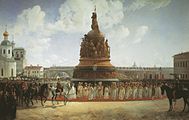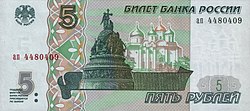Millennium of Russia
This article includes a list of references, related reading or external links, but its sources remain unclear because it lacks inline citations. (June 2014) (Learn how and when to remove this template message) |
Coordinates: 58°31′16.05″N 31°16′30.87″E / 58.5211250°N 31.2752417°E / 58.5211250; 31.2752417

The Millennium of Russia.

The Millennium of Russia (1862), with Saint Sophia Cathedral in the background. The upper row of figures is cast in the round and the lower one is in relief.
The Millennium of Russia (Russian Тысячелетие России) is a bronze monument in the Novgorod Kremlin. It was erected in 1862 to celebrate the millennium of Rurik's arrival to Novgorod, an event traditionally taken as a starting point of the history of Russian statehood.
A competition to design the monument was held in 1859. An architect Viktor Hartmann and an artist Mikhail Mikeshin were declared the winners. Mikeshin's design called for a grandiose, 15-metre-high bell crowned by a cross symbolizing the tsar's power. The bell was to be encircled with several tiers of sculptures representing Russian monarchs, clerics, generals, and artists active during various periods of Russian history.
Mikeshin himself was no sculptor, therefore the 129 individual statues for the monument were made by the leading Russian sculptors of the day, including his friend Ivan Schroeder and the celebrated Alexander Opekushin. Rather unexpectedly for such an official project, the tsars and commanders were represented side by side with sixteen eminent personalities of Russian culture: Lomonosov, Pushkin, Lermontov, Gogol, Karl Brullov, Mikhail Glinka, etc. As for the Russian rulers, Ivan the Terrible is famously absent from the monument due to his role in the 1570 pillage and massacre of Novgorod by the Oprichnina. Alongside the Muscovite princes, the mediaeval Lithuanian dynasts such as Gediminas or Vytautas the Great who reigned over the Eastern Slavs of the present-day Belarus and Ukraine are represented.
The most expensive Russian monument up to that time, it was erected at a cost of 400,000 roubles, mostly raised by public subscription. In order to provide an appropriate pedestal for the huge sculpture, sixteen blocks of Sortavala granite were brought to Novgorod, each weighing in excess of 35 tons. The bronze monument itself weighs 100 tons.

Commemorative coin issued in the USSR in 1988.
At the time when the monument was inaugurated, many art critics felt that it was overloaded with figures. Supporters regard Mikeshin's design as harmonious with the medieval setting of the Kremlin, and subtly accentuating the vertical thrust and grandeur of the nearby 11th-century Saint Sophia Cathedral.
During World War II, the Nazis dismantled the monument, and prepared it to be transported to Germany. However, the Red Army regained control of Novgorod and the monument was restored to public view in 1944. A 5-ruble commemorative coin was released in the USSR in 1988 to commemorate the monument.
| Wikimedia Commons has media related to Millennium of Russia. |
Contents
1 Middle level
2 Bottom level
3 Gallery
4 References
5 External links
Middle level
| Picture | Name | Name in Russian | Historical year | Description |
|---|---|---|---|---|
 | The arrival of the Varangians in Rus | Призвание варягов на Русь | 862 | The statue of the first warrior prince Rurik with helmet and shield with the inscription "year 6370" (since the creation of the world). Rurik wears a fur on his shoulders, behind him the pagan Slavic god Veles can be seen. The figure looks south-west, in the direction of Kiev. |
 | The Christianization of Rus | Крещение Руси | 988 | In the center, the Kievan Grand Prince Vladimir the Great can be found, raises an Orthodox cross. Besides, a woman holds her child for baptism and a Slav dispossesses the pagan god Perun. The composition looks in the south-eastern direction. |
 | Beginning of the expulsion of the Tatars | Начало изгнания татар | 1380 | Dmitry Donskoi, the victor in the Battle of Kulikovo, holds a Russian mace in his right hand. At his feet lies Mamai, the defeated warlord of the Golden Horde. In the left hand Dmitry Donskoi holds a captured bunchuk, the Tatar symbol of power. The composition looks east. |
 | Foundation of an independent Russian Tsardom | Основание самодержавного царства Русского | 1491 | Ivan the Great in a dress of Byzantine emperors with Monomach's Cap. In his hands he holds a scepter and a globus cruciger. In front of him, a Tatar is kneeling, beside him, a Lithuanian is lying, representing Grand Duchy of Lithuania, as well as a Teutonic knight with a broken sword, representing the Order of Teutonic Knights. The composition looks north-east. |
 | Enthronement of the Romanov dynasty | Начало династии Романовых | 1613 | The young Tsar Michael of Russia ascends to the Russian throne after the overcoming of the Time of Troubles. Prince Dmitry Pozharsky who represents the nobility protects him with his sword while Kuzma Minin who represents the people offers him the Monomach's Cap and the scepter. In the background, a figure of a Siberian Cossack can be found which symbolizes the colonization of Siberia to come. |
 | Creation of the Russian Empire | Образование Российской империи | 1721 | Peter the Great with laurel wreath and scepter in the right hand is supported by an angel showing him the way to the north-west where the future city of Saint-Petersburg shall be founded. At Peter's feet, defeated Swede can be found trying to protect his torn flag. This symbolizes the Russian victory in the Great Northern War. The composition looks north-west. |
Bottom level
Men of enlightenment: | Statesmen: | Military men and heroes: | Writers and artists: | ||||
 | Cyril and Methodius, missionaries of Slavs |  | Yaroslav the Wise, Grand Prince of Kiev |  | Sviatoslav I of Kiev, Grand Prince of Kiev |  | Mikhail Lomonosov, polymath |
 | Olga of Kiev, Grand Princess of Kiev |  | Vladimir Monomakh, Grand Prince of Kiev |  | Mstislav Mstislavich, Prince of Novgorod and Galicia |  | Denis Fonvizin, playwright |
 | Vladimir the Great, Grand Prince of Kiev |  | Gediminas, Grand Prince of Lithuania |  | Daniel of Galicia, Prince of Galicia |  | Alexander Kokorinov, architect |
 | Abraham of Rostov, bishop of Rostov |  | Algirdas, Grand Prince of Lithuania |  | Daumantas, Prince of Pskov |  | Gavrila Derzhavin, poet and statesman |
 | Anthony of Kiev, founder of the Monastery of the Caves |  | Vytautas, Grand Prince of Lithuania |  | Alexander Nevsky, Grand Prince of Vladimir |  | Fyodor Volkov, actor |
 | Theodosius of Kiev, Kievan monk |  | Ivan the Great, Grand Prince of Moscow |  | Michael of Tver, Prince of Tver |  | Nikolai Karamzin, playwright and historian |
 | Kuksha of the Kiev Caves, Kievan monk |  | Sylvester, clergyman and statesman |  | Dmitry Donskoi, Grand Prince of Moscow |  | Ivan Krylov, poet of fables |
 | Nestor the Chronicler, chronicler of the Russian history |  | Anastasia Romanovna, first wife of Ivan the Terrible |  | Kęstutis, Grand Prince of Lithuania |  | Vasily Zhukovsky, poet and translator |
 | Cyril of White Lake, Founder of the Kirillo-Belozersky Monastery |  | Alexey Adashev, Ivan IV's bosom friend and advisor |  | Daniil Kholmsky, general |  | Nikolay Gnedich, Poet and translator |
 | Stephen of Perm, Bishop and Missionary of Perm |  | Hermogenes, Patriarch of Moscow |  | Mikhail Vorotynsky, Field Marshal |  | Aleksandr Griboyedov, Writer and Diplomat |
 | Alexius of Moscow, Metropolitan of Kiev and Moscow |  | Michael Romanov, first Romanov tsar |  | Daniil Shchenya, military leader |  | Mikhail Lermontov, poet and writer |
 | Sergius of Radonezh, spiritual leader |  | Filaret, Patriarch of Moscow |  | Marfa Boretskaya, Posadnik of Novgorod |  | Alexander Pushkin, poet and writer |
 | Peter Mogila, Metropolitan of Kiev |  | Afanasy Ordin-Nashchokin, Diplomat |  | Yermak Timofeyevich, Cossack leader |  | Nikolai Gogol, Writer |
 | Zosima of Solovki, Founder of the Solovetsky Monastery |  | Artamon Matveyev, Statesman and Diplomat |  | Mikhail Skopin-Shuisky, military leader |  | Mikhail Glinka, Composer |
 | Maximus the Greek, Writer and scholar |  | Alexei I, Tsar |  | Dmitry Pozharsky, Prince |  | Karl Briullov, Painter |
 | Savvatiy, Founder of the Solovetsky Monastery |  | Peter the Great, Tsar and first emperor |  | Kuzma Minin, Organizer of the People's Army |  | Dmitry Bortniansky, Composer |
 | Jonah of Moscow, Metropolitan of Moscow |  | Yakov Dolgorukov, advisor to Peter I |  | Avraamy Palitsyn, Monk and Writer | ||
 | Macarius of Moscow, Metropolitan of Moscow |  | Ivan Betskoy, Statesman and Reformer |  | Bohdan Khmelnytsky, Hetman of the Zaporizhian cossacks | ||
 | Varsonofius of Tver, Archbishop of Tver |  | Catherine the Great, Empress | Ivan Susanin, Folk hero | |||
 | Guriy of Kazan, Archbishop of Kazan |  | Alexander Bezborodko, Statesman and Diplomat |  | Boris Sheremetev, Field Marshal and Diplomat | ||
 | Konstantin Ostrozhsky, Prince and voivode of Kiev |  | Grigory Potyomkin, Statesman and Diplomat |  | Mikhail Golitsyn, Field Marshal | ||
 | Nikon, Patriarch of Moscow |  | Viktor Kochubey, Statesman and Diplomat |  | Pyotr Saltykov, Field Marshal | ||
 | Fyodor Rtishchev, Philanthropist |  | Alexander I, Tsar |  | Burkhard von Münnich, Field Marshal | ||
 | Dimitry of Rostov, Churchman and composer |  | Mikhail Speransky, Statesman |  | Alexei Orlov, General | ||
 | Tikhon of Zadonsk, Archbishop of Ladoga and Voronezh |  | Mikhail Vorontsov, Field Marshal |  | Pyotr Rumyantsev, Field Marshal | ||
 | Mitrofan of Voronezh, Archbishop of Voronezh |  | Nicholas I, Tsar |  | Alexander Suvorov, Generalissimo | ||
 | Georgy Konissky, Archbishop of Belarus |  | Michael Barclay de Tolly, Field Marshal | ||||
 | Feofan Prokopovich, Archbishop of Novgorod; Statesman |  | Mikhail Kutuzov, Field Marshal | ||||
 | Platon Levshin, Metropolitan of Moscow |  | Dmitry Senyavin, Admiral | ||||
 | Innocent, Archbishop of Chersonesos Taurica |  | Matvei Platov, General | ||||
 | Pyotr Bagration, General | ||||||
 | Karl Diebitsch-Sabalkanski, Field Marshal | ||||||
 | Ivan Paskevich, Field Marshal | ||||||
 | Mikhail Lazarev, Admiral | ||||||
 | Vladimir Kornilov, Vice-Admiral | ||||||
 | Pavel Nakhimov, Admiral | ||||||
Gallery





Artwork by Bogdan Willewalde, the opening of the monument to the 1000th anniversary of Russia in Novgorod in 1862

Millennium of Russia on a 5-ruble banknote

The construction of the monument in 1862.

The Commemorative medal of the monument in 1862 when the construction was finished, "In memory of the Millennium of Russia"
References
External links
(in Russian) History and description on the website of the Novgorod administration







